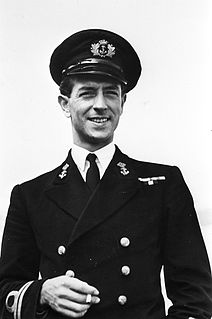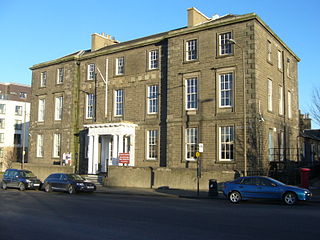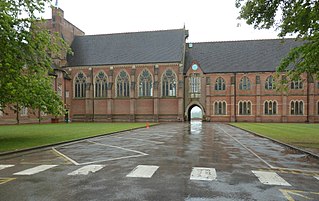
Etienne Henri "Hans" Larive, MWO, DSC and bar, was a Dutch naval officer during World War II. He escaped from the prisoner of war camp Oflag IV-C at Colditz Castle in 1941, and spent the rest of the war in England serving aboard Motor Torpedo Boats. He later wrote his memoir Vannacht varen de Hollanders (1950), which was republished translated into English as The Man Who Came in From Colditz (1975) – a pun on the best-selling novel The Spy Who Came in from the Cold.
835 Naval Air Squadron was a former squadron of the Royal Navy's Fleet Air Arm originally formed in February 1942 as a torpedo bomber and reconnaissance unit flying Fairey Swordfish. In June 1943, six Sea Hurricanes were added to the squadron as a fighter flight. The composite unit exchanged the Hurricanes in September 1944 for Grumman Wildcats, serving on until 1 April 1945, when the squadron disbanded.
Four ships and two shore establishments of the Royal Navy have borne the name HMS Forward:

The Commander-in-Chief, Portsmouth, was a senior commander of the Royal Navy for hundreds of years. The commanders-in-chief were based at premises in High Street, Portsmouth from the 1790s until the end of Sir Thomas Williams's tenure, his successor, Sir Philip Durham, being the first to move into Admiralty House at the Royal Navy Dockyard, where subsequent holders of the office were based until 1969. Prior to World War I the officer holder was sometimes referred to in official dispatches as the Commander-in-Chief, Spithead.

The Eastern Fleet, later called the East Indies Fleet, was a fleet of the Royal Navy which existed between 1941 and 1952.
HMS Forward was a shore establishment of the British Royal Navy during World War II. It was based at South Heighton, just outside Newhaven, East Sussex.

HMS Claverhouse was a shore establishment of the British Royal Navy, based at Granton, Edinburgh. It is a listed building, used as a training centre for E Squadron, 205 (Scottish) Field Hospital (Volunteers).

O 24, laid down K XXIV was an O 21-class submarine of the Royal Netherlands Navy that saw service during World War II. The most famous occupant of O-24 was Piet de Jong, who was the commanding officer from 1944 until 1946 and who later became Minister of Defence in 1963 and served as Prime Minister of the Netherlands from 1967 until 1971.

Captain Aston Dalzell Piper,, known as Peter Piper, was an officer in the Royal Naval Reserve in the Second World War. He was notable for two events: he was the first reservist to command a submarine, and the first reservist officer to receive the Distinguished Service Cross in the Second World War.
The Commander in Chief, Dover was an operational commander of the Royal Navy. His subordinate units, establishments, and staff were sometimes informally known as the Dover Command.

The Plans Division was the former war preparation and wartime strategic planning arm of the Admiralty Department from 1917 to 1964, The division originally became the main policy advisory and formulating body to the Chief of the Naval Staff. It later came under the supervision of the Assistant-Chief of the Naval staff (Policy).
The Commodore-in-Charge, Algiers was an administrative shore based appointment of the British Royal Navy established during World war II who was responsible for the berthing of all British convoys in Algeria and its sub-commands, facilities and staff from 1942 to 1946. The post holder was based at Allied Force Headquarters, Algiers. It was at first a sub-command of the Commander-in-Chief, Mediterranean Fleet then later the Commander-in-Chief, Levant.

The Rear-Admiral, Alexandria was an administrative shore based appointment of the British Royal Navy. The post was established during the Second World War, subordinate to the Commander-in-Chief, Mediterranean Fleet then later the Commander-in-Chief, Levant.

During the First World War, the Commander-in-Chief at the Cape, Rear Admiral Herbert King-Hall, expended much effort to destroy the elusive German light cruiser Königsberg.
Brighlingsea Naval Base was an installation of the British Royal Navy located at Brightlingsea, Essex, on the East Coast of England. It was a sub-area command under the Commander-in-Chief, The Nore from 1914 to 1921 and again from 1939 to 1945.

The Red Sea Station was a military formation of the Royal Navy. At various times it has also been referred to as Egypt Division and Red Sea and later the Red Sea and Canal Area. The Royal Navy had distinct formations for the Red Sea at intervals from 1846 until 1959. In that year it was unified with the Senior Naval Officer, Persian Gulf under the new appointment of Commodore, Arabian Seas and Persian Gulf.
The Rear-Admiral, Training Establishment Mediterranean was an command appointment of British Royal Navy established during World war II who supervised the training base HMS Canopus at Alexandria, Egypt He was subordinate to the Commander-in-Chief, Mediterranean Fleet.
The Senior British Naval Officer, Suez Canal Area was an administrative appointment of the Royal Navy established during World war II who was responsible for the naval base HMS Stag at Ismailia, Egypt. The SBNO was subordinate to the East Indies Station from 1939 to 1941 then the Mediterranean Fleet until 1942.







